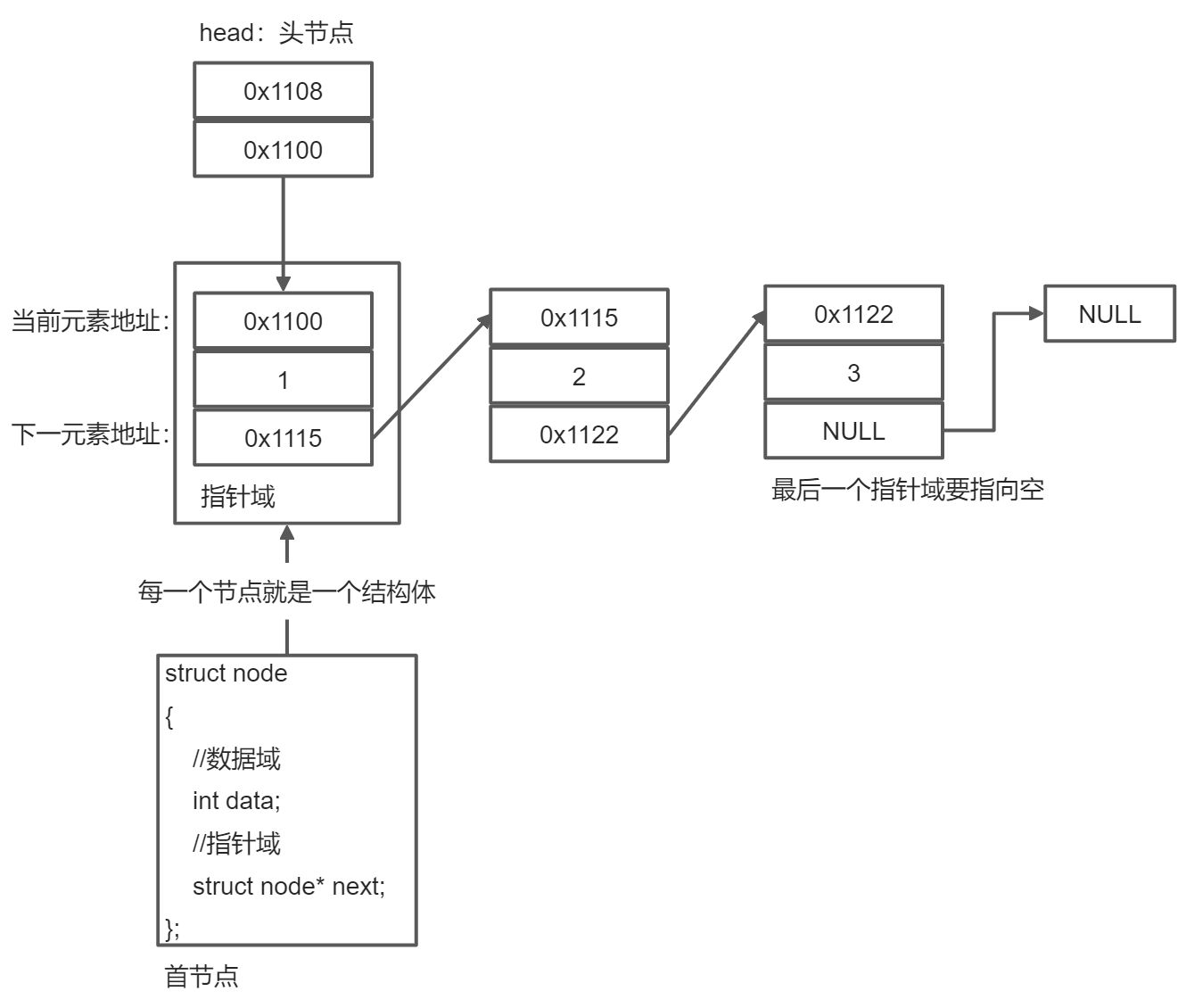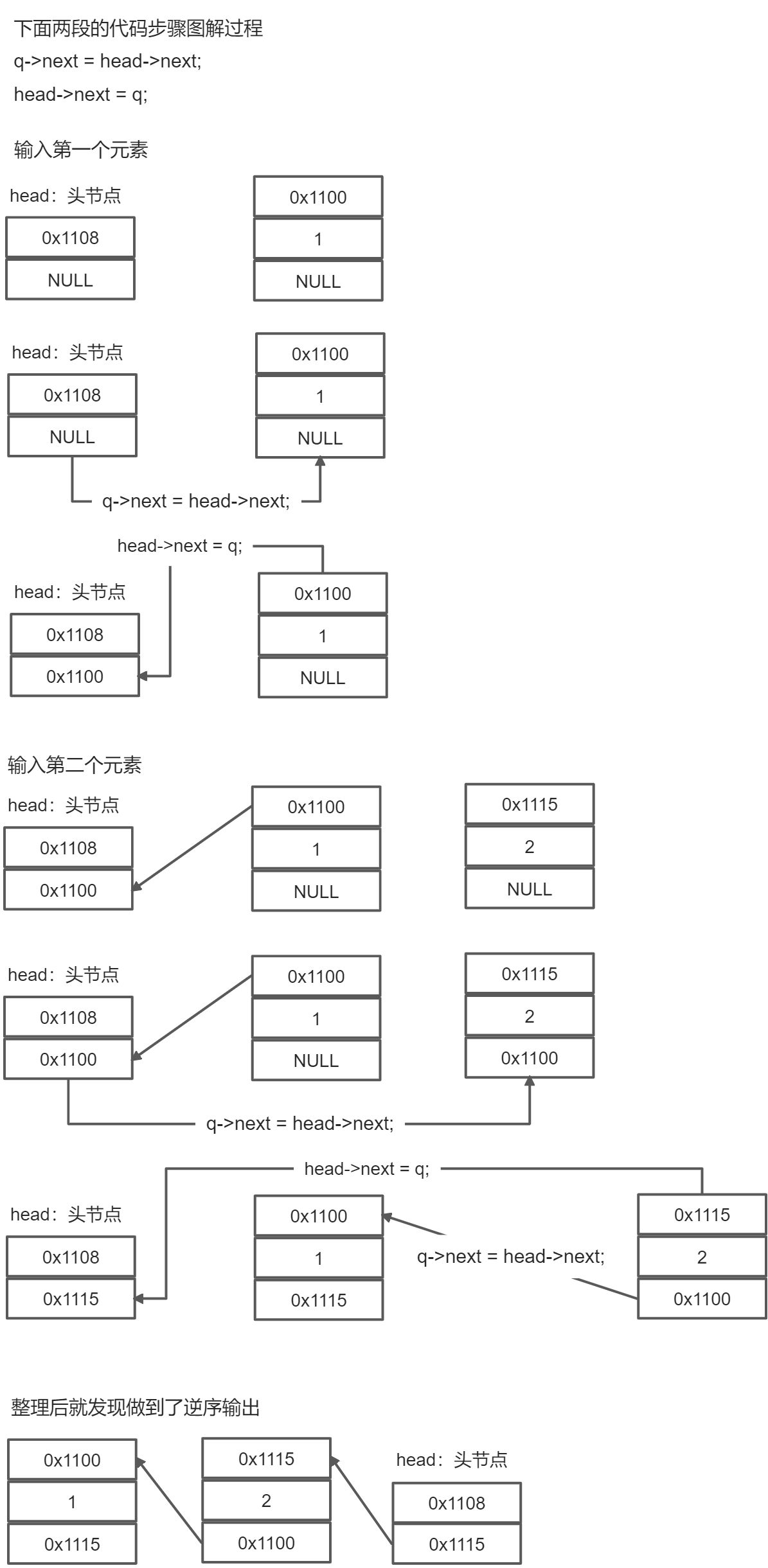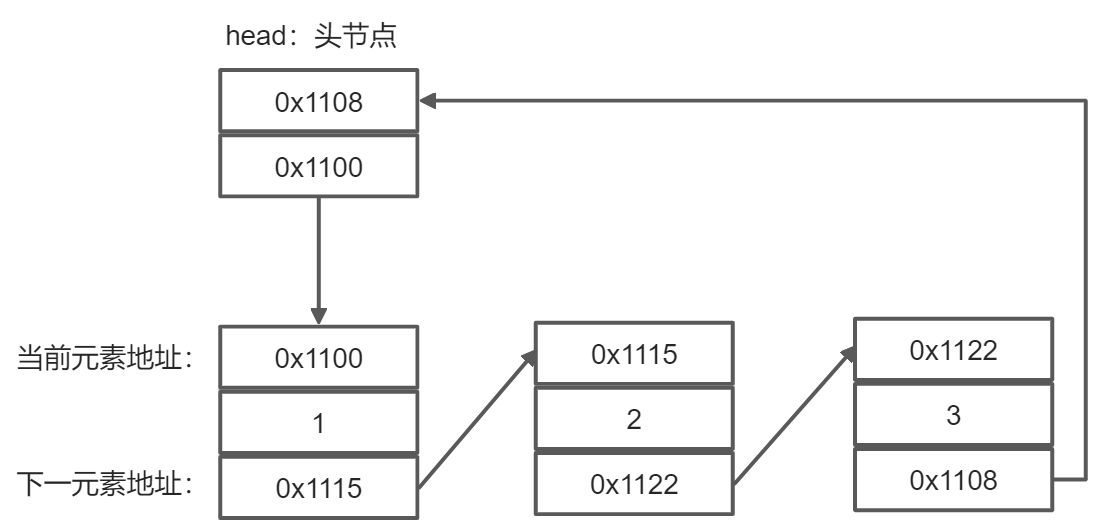- 链表是一种物理存储单元上非连续、非顺序的存储结构,数据元素的逻辑顺序是通过链表中的指针链接次序实现的。链表由一系列结点(链表中每一个元素称为结点)组成,结点可以在运行时动态生成
- 链表是随机分布在内存堆区的
- 节点:就是一个个结构体
与数组的区别:
数组是连续的内存,如果内存不够长就会出现数据超出内存的问题,链表就是为了解决这个问题
单向链表
单向链表图解

节点:一个一个的结构体
struct node{//数据域int data;//指针域struct node* next;//next就是指向下一个节点,指向方式就是保存下一个节点的地址,他读取的下一个节点也是同个类型,所以这里的指针类型用结构体本身};
数据域:节点里面存储的数据
指针域:指向下一个节点的指针
单向链表基础操作练习
创建单向连续链表并输出
新建一条含有n个节点带头节点的单链表,从键盘上输入节点的数据并打印整条链表
样例输入
5
1 2 3 4 5
样例输出:
1 2 3 4 5
#include<iostream>using namespace std;//循环写法struct node{int data;struct node* next;};//创建单向链表struct node* Create(){int n;cin >> n;struct node* head = (struct node*)malloc(sizeof(struct node));//在堆区新建一个头节点head->next = NULL;//把头节点的下一个节点地址置空,防止指针指向野指针//用last是因为head节点无法参与到后边节点的循环里,所用用last来承接,而且用last节点来循环遍历整个链,不会破坏原来节点的值/*last要保证每次输入后都在最后的一个节点,last节点会与相同地址的节点关联last步骤:当last还没移动,last->next获取到了当前输入节点的地址,会把当前输入节点的地址传给相同地址的节点,last下一步就会存入输入节点的地址,开始位移到当前输入的节点位置,重复上一步操作*/struct node* last = head;for (int i = 1; i < n; i++){struct node* q = (struct node*)malloc(sizeof(struct node));//在堆区新建一个节点cin >> q->data;//给当前节点输入一个值q->next = NULL;//当前暂无下一个节点,指向空//这两步不要反了,反了就不对了last->next = q;//把当前输入节点的地址保存到last->next里,此时last的位置还在当前输入节点的上一个节点,last->next的地址会传给当前last对应节点的next里(也就是当前输入节点的上一个节点)last = q;//让last的地址变为当前输入节点的地址,目的是让last能一直右移,保持在整段链表的最后}return head;}void Print(struct node* head){for (struct node* p = head->next; p != NULL; p = p->next)cout << p->data << endl;}int main(){struct node* head = Create();Print(head);return 0;}
从链表的头和尾插入新的节点
#include <iostream>using namespace std;#pragma warning(disable:4996)//节点类型struct node{int data;struct node* next;};//新建链表struct node* Create(){int n;cin >> n;struct node* head = (struct node*)malloc(sizeof(struct node));head->next = NULL;struct node* last = head;for (int i = 1; i <= n; i++){struct node* q = (struct node*)malloc(sizeof(struct node));cin >> q->data;q->next = NULL;last->next = q;last = q;}return head;}//往链表的开头插入新节点,struct node* H_insert(struct node* head){struct node* q = (struct node*)malloc(sizeof(struct node));cin >> q->data;q->next = NULL;//下面两句顺序不能搞反,否则会出现地址丢失问题q->next = head->next;//新的节点的next接收head节点的next相当于新节点的尾与原本的第一个节点链接head->next = q;//head的next接上新的节点就完成新节点插入头部的工作return head;}//往链表的结尾插入新节点struct node* T_insert(struct node* head){//新增一个节点struct node* q = (struct node*)malloc(sizeof(struct node));cin >> q->data;//往节点输入一个值q->next = NULL;//next指向空防止野指针//把已有的链表遍历到最后一个节点struct node* p = head->next;while (p->next)p = p->next;//将新建的节点地址,赋给原本链表的最后一个节点的next指针p->next = q;return head;}//打印void Print(struct node* head){for (struct node* p = head->next; p != NULL; p = p->next)cout << p->data << " ";cout << endl;}int main(){struct node* head = Create();Print(head);head = T_insert(head);Print(head);head = W_insert(head);Print(head);return 0;}
逆序输出链表
输入一行字符串,并以此建立一条带头节点的单链表,然后对该链表里的所有节点按输入时的逆序输出。
样例输入:
asdfg
样例输出:
gfdsa
也可以思考用递归做
#include <iostream>using namespace std;#pragma warning(disable:4996)struct node{char data;struct node* next;};//创建链表struct node* Create(){char c = '\0';//创建字符‘\0’代表没有字符struct node* head = (struct node*)malloc(sizeof(struct node));head->next = NULL;//链表逆序while ((c = getchar()) != '\n')//\n是回车,getchar()是从键盘获取字符,当输入字符是回车时退出循环{//创建节点struct node* q = (struct node*)malloc(sizeof(struct node));q->data = c;//给节点变量赋值q->next = NULL;指控指针,防止野指针q->next = head->next;//head->next的地址赋给当前节点的next,由于下一行代码的head的next保存了前一个节点的地址,这里就相当于当前节点指向上一个节点head->next = q;//用head的next接收当前节点的地址}return head;}void Print(struct node* head){struct node* p = head->next;while (p){putchar(p->data);//putchar()是输出字符的函数p = p->next;}}int main(){struct node* head = Create();Print(head);return 0;}
逆序建立两条链表并合二为一
先后读入2行字符,按照输入时的逆序建立一条带头节点的单链表,先分别输出每行字符,
然后把2条链表合成一条链表,输出整个链表的节点信息。
样例输入:
asdfg
zxcv
样例输出:
gfdsavcxz
#include <iostream>using namespace std;#pragma warning(disable:4996)struct node{char data;struct node* next;};//创建单向列表并逆序struct node *Create(){char c = '\0';struct node* head = (struct node*)malloc(sizeof(struct node));head->next = NULL;while((c=getchar())!='\n'){struct node* q = (struct node*)malloc(sizeof(struct node));q->data = c;q->next = NULL;q->next = head->next;head->next = q;}return head;}struct node *Sum(struct node *head1,struct node *head2){struct node* p = head1->next;//创建节点p位置在第一个头节点的首节点for (; p->next; p = p->next);//遍历head1的节点直到尾部p->next = head2->next;//把head1的尾节点与head2开头的链表的首节点连起来free(head2);//把head2释放,因为head2已经没有关联任何节点return head1;}void Print(struct node *head){struct node* p = head->next;while(p){putchar(p->data);p = p->next;}}int main(){struct node* head1 = Create();struct node* head2 = Create();Print(Sum(head1, head2));return 0;}
删除单链表中某个元素
#include <iostream>using namespace std;#pragma warning(disable:4996)struct node{char data;struct node* next;};//创建单向链表struct node *Create(){int n;cin >> n;struct node* head = (struct node*)malloc(sizeof(struct node));head->next = NULL;struct node* last = head;for (int i = 1; i <= n; i++){struct node* q = (struct node*)malloc(sizeof(struct node));cin >> q->data;q->next = NULL;last->next = q;last = q;}return head;}//删除:值为3节点struct node* Delete(struct node* head){int data;cout << "请输入要删除的值:";cin >> data;//创建两个节点来判断要删除的位置,用两个节点可以更好的做链接struct node* pre = head;//创建一个节点,位置在head上struct node* p = head->next;//创建一个节点在head链表的首节点上while (p->next){if (p != NULL && p->data == data)//判断当前节点的值是否与输入的值相等。相等且不为空则进入此行{pre->next = p->next;//free(p);p = pre->next;}else{//如果不满足上边条件,则pre和p个往前走一步pre = pre->next;p = p->next;}}return head;}//打印链表void Print(struct node *head){for (struct node* p = head->next; p != NULL; p = p->next)cout << p->data << " ";cout << endl;}int main(){struct node* head = Create();Delete(head);Print(head);return 0;}
删除单链表中连续相同的数据
样例输入:
12
1 2 3 2 2 2 4 5 6 6 6 7
样例输出:
1 2 3 2 4 5 6 7
#include <iostream>using namespace std;#pragma warning(disable:4996)struct node{char data;struct node* next;};//创建链表struct node *Create(){int n;cin >> n;struct node* head = (struct node*)malloc(sizeof(struct node));head->next = NULL;struct node* last = head;for (int i = 1; i <= n; i++){struct node* q = (struct node*)malloc(sizeof(struct node));cin >> q->data;q->next = NULL;last->next = q;last = q;}return head;}//删除链表中连续相同的数据void Delet_link_same(struct node* head){struct node* pre = head->next;struct node* p = pre->next;while (p){if (p->data == pre->data){struct node* temp = p;p = p->next;free(temp);}else{pre->next = p;pre = p;p = p->next;}}pre->next = NULL;}//打印链表void Print(struct node *head){for (struct node* p = head->next; p != NULL; p = p->next)cout << p->data << " ";cout << endl;}int main(){struct node* head = Create();Delet_link_same(head);Print(head);return 0;}
链表排序
从键盘上输入n个整数,并以此建立一条带头节点的单向链表,然后对链表中的数据进行升序排列,并输出
样例输入:
10
10 9 8 7 6 5 4 3 2 1
9 10
8 9
7 8
6 7
5 6
4 5
3 4
2 3
1 2
样例输出:
1 2 3 4 5 6 7 8 9 10
#include <iostream>using namespace std;#pragma warning(disable:4996)struct node{char data;struct node* next;};//创建链表struct node *Create(){int n;cin >> n;struct node* head = (struct node*)malloc(sizeof(struct node));head->next = NULL;struct node* last = head;for (int i = 1; i <= n; i++){struct node* q = (struct node*)malloc(sizeof(struct node));cin >> q->data;q->next = NULL;last->next = q;last = q;}return head;}//升序排列:把值进行交换就行void Sort(struct node* head){struct node* p, * q;for(p=head->next;p;p=p->next){for (q = p->next; q; q = q->next){if (p->data > q->data){swap(p->data, q->data);}}}}//打印链表void Print(struct node *head){for (struct node* p = head->next; p != NULL; p = p->next)cout << p->data << " ";cout << endl;}int main(){struct node* head1 = Create();struct node* head2 = Create();Print(Sum(head1, head2));return 0;}
单向循环链表图解
单循环链表练习
创建一个循环链表
#include <iostream>
using namespace std;
#pragma warning(disable:4996)
struct node
{
char data;
struct node* next;
};
struct node* Create()
{
//这里都是创建链表的过程
struct node* head = (struct node*)malloc(sizeof(struct node));
head->next = NULL;
struct node* last = head;
char c;
while ((c = getchar()) != '\n')
{
struct node* q = (struct node*)malloc(sizeof(struct node));
q->data = c;
q->next = NULL;
last->next = q;
last = q;
}
//这里是创建环
last->next = head; //闭环
return head;
}
void Print(struct node* head)
{
struct node* p = head->next;
while (p != head)
{
cout << p->data;
p = p->next;
}
cout << endl;
}
int main()
{
struct node* head = Create();
Print(head);
return 0;
}
判断链表是否有环,环的入口
#include <iostream>
using namespace std;
#pragma warning(disable:4996)
struct node
{
char data;
struct node* next;
};
struct node* Create()
{
struct node* head = (struct node*)malloc(sizeof(struct node));
head->next = NULL;
struct node* last = head;
char c;
while ((c = getchar()) != '\n')
{
struct node* q = (struct node*)malloc(sizeof(struct node));
q->data = c;
q->next = NULL;
last->next = q;
last = q;
}
struct node* p = head->next->next->next->next; //第4个数据节点做为环形链表的入口
last->next = p; //闭环
return head;
}
//判断是否有环
//判断是否有环用两个节点来赛跑,一个节点走两步,一个节点走一步,如果有环,快的一定会追上慢的,否则永远追不上
struct node* ExitLoop(struct node* head)
{
struct node* fast, * slow;
fast = slow = head;//两个节点都从头节点出发
while (slow && fast->next)
{
slow = slow->next;//slow每次走一步
fast = fast->next->next;//fast每次走两步
if (slow == fast)//fast追上slow证明有环
return slow;
}
return NULL;
}
//找到环的入口点:从链表起点head到入口点的距离 == 相遇点到入口点的距离
struct node* FindLoopStart(struct node* head)
{
struct node* p1 = head;//p1从链表的头开始
struct node* p2 = ExitLoop(head);//p2从之前在环相遇的地方开始
while (p1 != p2)//两节点相遇,就是环的起点
{
p1 = p1->next;
p2 = p2->next;
}
return p1;
}
void Print(struct node* head)
{
struct node* p = head->next;
while (p != head)
{
cout << p->data;
p = p->next;
}
cout << endl;
}
int main()
{
struct node* head = Create();
cout << FindLoopStart(head)->data << endl;
// Print(head);
return 0;
}
双向链表
双向链表图解

双向链表节点:
struct node
{
//数据域
int data;
//指针域
struct node* prior//双向链表使用的,让链表从尾指向头
struct node* next;
};
双向链表练习
创建双向链表
#include<iostream>
using namespace std;
struct node
{
int data;
struct node* next, * prior;
};
//创建链表
struct node* Create1()
{
cout << "创建双向链表: ";
struct node* head = (struct node*)malloc(sizeof(struct node));
head->next = NULL;
head->prior = NULL;
struct node* last = head;//last从头开始出发
char c = '\0';//初始化字符变量
while ((c = getchar()) != '\n')//当输入是回车的时候退出循环
{
创建存有变量的节点
struct node* p = (struct node*)malloc(sizeof(struct node));
p->data = c;//存入变量
p->next = NULL;
p->prior = NULL;
last->next = p;//用last来把last所在的节点与当前的节点p链接
p->prior = last;让p链接last所在的节点,形成一个回链,达成双向链表的效果
last = p;//把last的位置移动到当前p的位置
}
return head;
}
void Print1(struct node* head)
{
cout << "正序:";
struct node* p = head->next;//从首节点出发
while (p)//当p指向空时停止循环
{
putchar(p->data);//输出字符
p = p->next;//p一直往前走
}
cout << endl;
}
int main()
{
struct node* head = Create1();
Print1(head);
return 0;
}
删除链表中第几个元素
#include<iostream>
using namespace std;
struct node
{
int data;
struct node* next, * prior;
};
struct node* Create1()
{
cout << "创建双向链表: ";
struct node* head = (struct node*)malloc(sizeof(struct node));
head->next = NULL;
head->prior = NULL;
struct node* last = head;
char c = '\0';
while ((c = getchar()) != '\n')
{
struct node* p = (struct node*)malloc(sizeof(struct node));
p->data = c;
p->next = NULL;
p->prior = NULL;
last->next = p;
p->prior = last;
last = p;
}
return head;
}
void Print1(struct node* head)
{
cout << "正序:";
struct node* p = head->next;
while (p)
{
putchar(p->data);
p = p->next;
}
cout << endl;
}
struct node* DeleteNode(struct node* head)
{
cout << "删除第几个节点:";
int n;
cin >> n;
struct node* p = head;
int i = 0;//计算循环次数,控制节点位移的位置
while (p->next && i < n)//当p->next不是空时,i小于输入的节点位置就循环
{
p = p->next;//p一直走走到要删除的位置停下
i++;
}
if (i == n)//当i等于n,表示到了删除的位置
{
if (p->next)
{
p->next->prior = p->prior;//p的下一个节点的prior的地址变为p上一个节点的地址
}
p->prior->next = p->next;//p上一个节点的next的地址变为p下一个节点的地址
free(p);//释放p,删除p所在的节点
}
return head;
}
int main()
{
struct node* head = Create1();
DeleteNode(head);
Print1(head);
return 0;
}
逆序输出
#include<iostream>
using namespace std;
struct node
{
int data;
struct node* next, * prior;
};
struct node* Create2()
{
cout << "创建双向链表: ";
struct node* head = (struct node*)malloc(sizeof(struct node));
head->next = NULL;
head->prior = NULL;
struct node* last = head;
char c = '\0';
while ((c = getchar()) != '\n')
{
struct node* p = (struct node*)malloc(sizeof(struct node));
p->data = c;
p->next = NULL;
p->prior = NULL;
last->next = p;
p->prior = last;
last = p;
}
return last;//last的位置就在整个链的最后,直接返回last做为头节点使用就可以倒序输出
}
void Print2(struct node* last)
{
cout << "倒序:";
struct node* p = last;//last做头节点
while (p->prior)
{
//用prior就就可以从后往前走
putchar(p->data);
p = p->prior;
}
cout << endl;
}
int main()
{
struct node* last = Create2();
Print2(last);
return 0;
}
插入元素,这个代码有问题要去问老师
#include<iostream>
using namespace std;
struct node
{
int data;
struct node* next, * prior;
};
struct node* Create1()
{
cout << "创建双向链表: ";
struct node* head = (struct node*)malloc(sizeof(struct node));
head->next = NULL;
head->prior = NULL;
struct node* last = head;
char c = '\0';
while ((c = getchar()) != '\n')
{
struct node* p = (struct node*)malloc(sizeof(struct node));
p->data = c;
p->next = NULL;
p->prior = NULL;
last->next = p;
p->prior = last;
last = p;
}
return head;
}
void Print1(struct node* head)
{
cout << "正序:";
struct node* p = head->next;
while (p)
{
putchar(p->data);
p = p->next;
}
cout << endl;
}
struct node* InsertNode(struct node* head)
{
cout << "在第几个节点后插入:";
int n;
cin >> n;
struct node* q = (struct node*)malloc(sizeof(struct node));
cout << "请输入要插入的值:";
cin >> q->data;
q->next = NULL;
q->prior = NULL;
struct node* p = head;
int i = 0;
while (p->next && i < n)
{
p = p->next;
i++;
}
if (i == n)
{
if (p->next)
{
q->next = p->next;
p->next->prior = q;
}
p->next = q;
q->prior = p;
}
return head;
}
int main()
{
struct node* head = Create1();
InsertNode(head);
Print1(head);
return 0;
}
回文链表
请判断一个链表是否为回文链表。
示例 1:
输入: 1->2
输出: false
示例 2:
输入: 1->2->2->1
输出: true
#include<iostream>
using namespace std;
struct node
{
char data;
struct node* next, * prior;
};
//创建链表
void Create(struct node*& head, struct node*& last)//这里是为了把head和last都传下去,而不只是返回一个变量
{
head = (struct node*)malloc(sizeof(struct node));
head->next = NULL;
head->prior = NULL;
last = head;
char c;
while ((c = getchar()) != '\n')
{
struct node* q = (struct node*)malloc(sizeof(struct node));
q->data = c;
q->next = NULL;
q->prior = NULL;
last->next = q;
q->prior = last;
last = q;
}
}
int Is_hw(struct node* head, struct node* last)
{
struct node* p = head->next;
struct node* q = last;
for (; p != q && p != NULL; p = p->next, q = q->prior)//偶数个节点的时候p是不会等于q的,所以需要p!=NULL来限制
{
if (p->data != q->data)
break;
}
if (p == q || p == NULL)
return 1;
else
return 0;
}
int main()
{
struct node* head, * last;
Create(head, last);
cout << Is_hw(head, last) << endl;
return 0;
}
合并 k 个排序链表
合并 k 个排序链表,返回合并后的排序链表。
示例:
样例输入:
3
3
1 4 5
3
1 3 4
2
2 6
样例输出:
1 1 2 3 4 4 5 6
#include <iostream>
using namespace std;
#pragma warning(disable:4996)
struct node
{
int data;
struct node* next;
};
void Create(struct node*& head, struct node*& last)//这里的&是引用
{
head = (struct node*)malloc(sizeof(struct node));
head->next = NULL;
int n;
cout << "输入节点个数:";
cin >> n;
last = head;
cout << "输入节点数据:" << endl;
for (int i = 1; i <= n; i++)
{
struct node* q = (struct node*)malloc(sizeof(struct node));
cin >> q->data;
q->next = NULL;
last->next = q;
last = q;
}
}
void Print(struct node* head)
{
struct node* p = head->next;
while (p)
{
cout << p->data << " ";
p = p->next;
}
cout << endl;
}
void Sort(struct node* head)
{
struct node* p, * q, * min;
for (p = head->next; p; p = p->next)
{
for (min = p, q = p->next; q; q = q->next)
{
if (min->data > q->data)
{
min = q;
}
}
swap(p->data, min->data);
}
}
int main()
{
struct node* head1, * last1, * head2, * last2;
int k;
cout << "输入K的值:";
cin >> k;
Create(head1, last1);//struct node*& head=head1;
struct node* p = last1;
for (int i = 1; i < k; i++)
{
Create(head2, last2);
p->next = head2->next;
p = last2;
free(head2);
}
Sort(head1);
Print(head1);
return 0;
}





